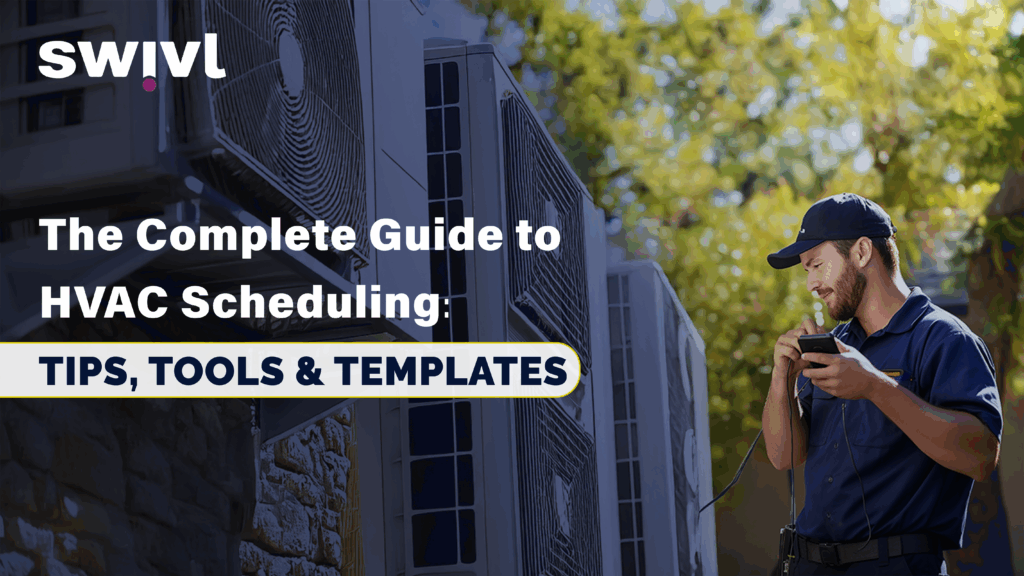The technician’s stuck in traffic, the next customer’s already calling, and suddenly your whole schedule is scrambling to catch up. If you’ve been there, you know the truth in HVAC, scheduling can make or break your day.
It’s not just about putting jobs on a calendar. It’s about sending the right tech to the right place at the right time, with the right tools, without wasting hours on the road or overlapping appointments. When scheduling goes wrong, everyone feels it: customers, technicians, your office team, and your bottom line.
This guide is here to help you fix that. Whether you’re still working off spreadsheets or already using HVAC scheduling software, we’ll walk you through practical ways to tighten up your process. From choosing the right tools and templates to automating dispatch and training your team, we’ll help you build a scheduling system that’s clear, flexible, and ready for anything 2025 throws your way.
Why Good HVAC Scheduling Matters
Even a minor scheduling error can disrupt your entire day. A technician arrives late. The wrong person is dispatched for a job requiring certification. A service call is missing from the calendar entirely. These issues aren’t just inconvenient; they create downstream inefficiencies that affect customer satisfaction, resource allocation, and revenue.
Effective HVAC scheduling ensures operational alignment: the right technician, equipped with the right tools, is deployed to the correct location at the designated time.
When executed properly, it delivers measurable benefits:
- Reduces unnecessary travel and overtime by improving route and workload distribution
- Minimizes reactive scheduling caused by cancellations or misassignments
- Improves first-time fix rates by aligning skillsets to job types
- Boosts team productivity and customer satisfaction through reliable, predictable service delivery
What a Good HVAC Scheduler Should Do
A good HVAC scheduler, whether it’s a person or a software platform, should bring clarity and control to your daily operations. It should give you a real-time view of which technicians are available, what skills they bring to the table, and where they are throughout the day.
The right scheduler helps match the right person to the right job, not just based on timing, but on qualifications and proximity. It should also factor in customer preferences, like specific time windows, and be flexible enough to handle last-minute changes or emergency calls without creating a domino effect of delays.
Beyond the field, a great scheduler connects with your CRM, invoicing, and work order systems, ensuring that everyone, from the back office to the technician on-site, is working with the same accurate, up-to-date information.
At the end of the day, it’s not just about putting names on a calendar; it’s about running a smarter, more responsive HVAC operation.
Common HVAC Scheduling Problems (And How to Fix Them)
If you’ve been in the game long enough, you’ve probably run into some of these:
| Problem | What Happens | Smart Fix |
| Last-minute cancellations | Wasted time, revenue loss | Send automated SMS/email reminders |
| Overbooking | Angry customers rushed tech | Add buffer time and color-code job types |
| Understaffing | Slower response lost leads | Use tools that flag overloads in advance |
| Poor communication | Missed jobs, wrong tools | Switch to mobile-friendly field apps |
| Paper-based systems | Human error, forgotten jobs | Use cloud-based platforms that sync instantly |
5 HVAC Scheduling Tips That Work (In 2025)
Want fewer delays, happier customers, and a more productive field team? These HVAC scheduling tips will help you streamline operations and stay ahead of the curve:
- Replace Spreadsheets with Smarter Solutions
Outdated tools like Excel or whiteboards might work in a pinch, but they can’t keep up with the real-time pace of HVAC operations. A centralized, cloud-based scheduler, such as Swivl, ensures everyone is looking at the same plan, whether they’re in the office or on the move. It eliminates miscommunication, double-bookings, and unnecessary phone calls between dispatch and technicians. - Automate customer reminders
Don’t let no-shows eat into your revenue. Set up automated appointment reminders via text and email to confirm bookings, reduce cancellations, and improve overall customer reliability. Platforms like Swivl let you schedule these communications directly within the job workflow, so it all happens without manual follow-up. - Segment your jobs visually
Using color codes for different job types, like red for emergency calls, blue for installations, and green for routine maintenance, makes it much easier to spot scheduling conflicts or overloading. Tools like calendar view support visual tagging, helping you organize at a glance and plan proactively across your week. - Leave some breathing room
Build buffer time into your scheduling blocks. It’s a small adjustment that makes a big difference when jobs run long, traffic hits, or technicians need time to grab parts. Swivl allows you to set custom job durations and break periods to keep schedules realistic and reduce tech fatigue. - Stay flexible with real-time control
HVAC schedules rarely stay fixed. Technicians get delayed. Customers cancel. Emergencies pop up. That’s why having mobile-first software like Swivl is a game-changer. Dispatchers can reassign or reschedule jobs on the fly, and technicians get updates instantly on their mobile app, keeping everyone aligned, even on the busiest days.
Why CRM & Invoicing Integration Matters
Scheduling is just one component of a much larger HVAC operations ecosystem. Even with a well-structured calendar, if your system doesn’t connect with estimates, invoicing, customer records, or payment tracking, inefficiencies and bottlenecks will persist. This is where full workflow integration becomes crucial.
When your HVAC dispatch software, especially a solution like Swivl, which offers free HVAC dispatch software options, integrates directly with your CRM, your team gains access to vital customer data in real time. From equipment specifications to service history and prior issues, technicians are better prepared before arriving on-site.
This improves job accuracy, reduces repeat visits, and allows for more personalized service delivery. It also enables automated features like recurring preventive maintenance scheduling or upgrade prompts based on historical work.
On the financial side, integrating scheduling with invoicing and payments means you can generate and send invoices immediately after a job, accept mobile payments securely in the field, and track payment statuses all without relying on paper forms or manual reconciliation.
For teams undergoing HVAC dispatcher training, platforms like Swivl simplify onboarding by offering pre-built work order templates, visual scheduling tools, and intuitive dashboards. These features help new dispatchers assign jobs more effectively, balance workloads, and manage technician availability without error. Ultimately, an integrated, end-to-end system streamlines every touchpoint from first contact to final payment, boosting both operational speed and customer satisfaction.
Track These KPIs to See If It’s Working
- First-Time Fix Rate
Indicates how often technicians resolve issues on the first visit, critical for measuring job preparedness and service quality. - On-Time Arrival Rate
Tracks whether technicians are arriving at job sites as scheduled, helping identify issues with overbooking or time estimation. - Average Travel Time per Job
Measures efficiency in routing and technician assignment; high travel time suggests poor geographic scheduling. - Job Completion Rate
Reflects the percentage of scheduled jobs that are completed within the expected timeframe. - CSAT (Customer Satisfaction Score)
Captures customer feedback post-service to evaluate satisfaction with the technician, timing, and overall service experience.
Conclusion
HVAC businesses that excel in today’s service-driven environment do more than arrive on time; they operate strategically, respond efficiently, and maintain a high standard of service delivery. In this context, HVAC scheduling software has become a critical operational tool, not a discretionary upgrade.
Solutions like Swivl offer an integrated platform that connects scheduling, dispatch, CRM, and payments, enabling end-to-end workflow visibility and control.Whether you’re expanding your workforce or navigating peak service periods, relying on manual tools like whiteboards or spreadsheets often leads to avoidable errors and inefficiencies.
By using HVAC scheduling templates, whether in Excel or through a cloud-based platform, you can streamline job assignments, avoid overlaps, and maintain consistency across your operations. Investing in a centralized digital system ensures better coordination, reduces administrative workload, and improves technician performance and client satisfaction. In short, a well-structured HVAC scheduling templates isn’t just a time-saver; it’s a foundation for sustainable business growth.




